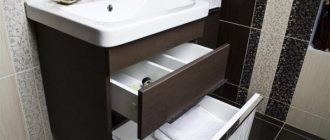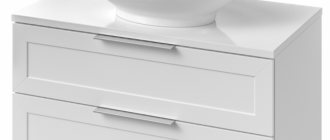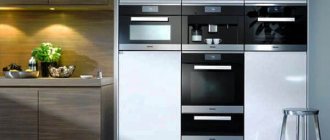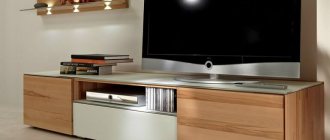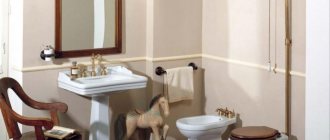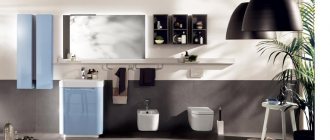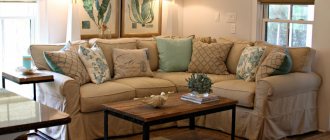A bathroom is not just a place where there is a bathtub. In addition to it, there is often a sink intended for washing; moreover, it is a good interior element, which should have a decent frame in the form of a cabinet. The cabinet itself will not only decorate the room, but will also provide the ability to store various bottles and household cleaning products. You can buy it, or you can make it yourself. How to make a bathroom vanity cabinet with your own hands?
DIY bathroom vanity cabinet
Buy or make it yourself?
You always want to make your bathroom not only beautiful, but also functional. And well-chosen furniture and other interior items will help with this. As a rule, a lot of bottles, jars, and rags are always stored in this room, which are needed not only for taking care of yourself and your appearance, but also for cleaning the premises. And when it’s all just put together haphazardly and using whatever, the picture turns out to be unflattering. It is much better to use some kind of furniture to store items.
Small cabinet under the washbasin - DIY options
One of these interior items is just a cabinet under the sink. Usually it not only hides the drain running from the sink itself to the sewer pipes, but also has a lot of shelves hidden behind the doors. And on these shelves you can put all kinds of bottles and boxes - there they will not be conspicuous and disturb anyone with their presence.
Of course, the easiest way is to just buy a sink cabinet. Nowadays all kinds of products are produced from a variety of materials, having any shapes and sizes. But it cannot be denied that our apartments are such that they do not always meet any standards. And for this reason, choosing a cabinet for a sink is often not easy. In this case, you should just think about doing it yourself.
Built-in vanity unit
On a note! The question arises - why not order a cabinet from a professional? The answer is simple - not everyone can afford to pay for an expensive custom-made designer item. Sometimes it is much cheaper and easier to do everything yourself. But you will have to spend your personal time. Plus, private craftsmen can be very busy with work, and they will have to wait for more than one month for their cabinet.
It is important to understand that not everyone can make a cabinet - you need to have certain work skills. But if there is a desire, then even a beginner will definitely succeed in creating a cabinet. You just need to put in more effort and study all the necessary information in advance. And it’s better to choose a model that is as simple as possible - complex options may not work out the first time without the proper skills.
Cabinet with drawers under the sink
Cabinet for built-in sink
As for the cabinet with a built-in sink, it is rightfully considered universal. Why? The fact is that it can be used in the future for an overhead sink. As an example, let’s consider the option of making a cabinet with a width of 60 cm. In general, the following blanks will be required:
- Sidewalls of the cabinet 2 pieces – 820×550 mm.
- The bottom for the cabinet is 568×550 mm.
- 3 drawers and base of the cabinet – 568×100 mm. If a cabinet is being made for an overhead sink, then such a model will require only two drawers.
As a result, such a cabinet will have the following dimensions: 850×600×600 mm. In this case, laminated chipboard should be used, the thickness of which is 16 mm.
As for the facades, here they will have the following dimensions:
- There are two doors - 565x297 mm.
- Horizontal false panel – 596×147 mm.
A tabletop measuring 600×600 mm is also prepared.
When assembling all the parts, it is important to take into account some nuances. The workpieces must be cut without chipping. The ends must be edged. This will protect the future cabinet from swelling when in contact with water.
Even slight damage to the surface of the slab can ruin the entire job. In this place, the cabinet will absorb moisture, for this reason all work should be done accurately and carefully.
All parts are connected with furniture corners from the inside, and some parts are secured with screws. As in all other cases, the gap between the sink and the countertop needs to be well siliconed. Using all of the above blanks, you can make a cabinet for a built-in sink.
Photo instructions:
Types of cabinets
Cabinets can have not only different sizes, but also different shapes. They can also be divided into several types depending on the method of their installation and location.
Cabinets may be different
Table. Varieties of sink cabinets depending on the installation method.
| View | Description |
| Floor | This is the most popular model, and its popularity is due to the versatility of products in this category. Such cabinets are distinguished by their stability and simplicity of design, and you can also place fairly heavy objects in them, since there is no risk of collapse. Typically, such products have legs or a base. Often they can be additionally fixed on the wall, which increases their reliability. Models can completely close communications. But they are unlikely to be suitable for modest-sized bathrooms, as they occupy quite a large space. However, with the right selection of models, they will look good and be useful. But putting a washing machine in a bathroom with such a cabinet can be problematic. |
| Hanging | These are, as a rule, very interesting and light-looking models that take up very little space, as they are located directly under the sink itself. They are especially relevant in small rooms and where plumbing does not allow the installation of a monolithic floor structure. However, the wall on which such a cabinet is fixed must be strong and reliable. Also, usually you cannot put heavy objects in such furniture. They are more difficult to install than floor-mounted ones, which often discourages the choice of such a model. But, nevertheless, this is also a popular form. |
| Corner | It is easy to guess that such cabinets are installed in the corner of the room. Moreover, they can be both floor-mounted and suspended. Allows you to save free space and decorate the interior. The optimal solution for small spaces. The cavity of such a cabinet is usually very spacious and allows you to hide many things and objects from prying eyes. |
Hanging cabinet
Also, cabinets can be divided into two types depending on the type of bowl of the sink itself. Thus, they distinguish cabinets for a mortise sink, when the thicket itself is installed on the upper surface of the cabinet by cutting out a cavity in it for it. Here it is important to take into account the fact that the plumbing product fits tightly to the edges of the cabinet , and the hole for it is accurate. Otherwise, unsightly gaps may form.
There are also cabinets for an overhead sink. Such a bowl is installed on top of the furniture itself - a small barrier is created on the countertop from the boundaries of the sink.
There is a wide range of different and interesting models of sink cabinets on sale.
Prices for vanity units
Vanity cabinet
On a note! There are also so-called consolidated washbasins. They are connected to the cabinet itself, representing a solid structure. You won’t be able to do this yourself, except in rare cases, and then only with a high level of skill.
Assembly with preliminary preparation
First, the figured cut and processing are performed. To do this, you need to take a jigsaw with a saw to cut wood and chipboard. Now place the drop-in sink on the back of the countertop.
It is best to cut from the reverse side as well. In this case, all chips will remain inside. If it is more convenient for you to do the opposite, then you can use a file with reverse sharpening. Before cutting, you should retreat 16 mm from the front edge for the drawer.
One of the difficult moments is cutting out the false panel for a shaped sink. Therefore, it is worth reminding again to carry out all your actions carefully and think through them in advance.
When making a cabinet, it is recommended to treat all cut areas with silicone sealant. At the same time, you shouldn’t feel sorry for him.
In each case, the assembly of the drawers, bottom and side parts is carried out according to the same principle. To confirm, it is necessary to drill through holes in the plane of the sidewalls, the diameter of which should be eight millimeters. The trim of the base, side and bottom is drilled with a 5 mm drill. The hole depth should be 60 mm. It is necessary to retreat up to 50 mm from the edges. The tabletop and false panel are attached using furniture corners with 4×16 self-tapping screws. If we talk about confirmations, then choose standard ones, 5x70 mm in size. To secure the facades, it is necessary to install hinges. For this, holes are drilled. Measure 140 mm from the top, 60 mm from the bottom, and 22 mm from the end of the door. For the hole, it is recommended to use a special loop cutter with a diameter of 35 mm. In the end, all that remains is to install the legs on the bottom of the structure. They are also secured with self-tapping screws.
All that remains is to fit the cabinet under the sink.
Materials for cabinets
In general, vanity cabinets can be made from a wide variety of materials, differing in appearance and physical characteristics. The correct choice of material greatly influences the possibility of making a homemade cabinet and its final service life. So, this type of furniture can be made of MDF, wood, plasterboard, glass, plastic, metal, ceramics. The latter option will not be considered, since it is unlikely that it will be possible to make a ceramic product of suitable shape and parameters at home. So we will talk about materials that are simpler and more accessible to work with.
Photo of a beautiful and original bedside table
So, wood is an indispensable type of material for creating homemade furniture . It is characterized by ease of processing, long service life, and environmental friendliness. But it is important to understand that in conditions of high humidity, this material quickly loses its appearance and becomes unusable. Therefore, when using wood to create a sink cabinet, it is important to consider that it must be treated with protective compounds that will not allow mold and mildew to develop and can protect the wood from quickly losing its beautiful appearance.
Finished countertop in the bathroom
Also, instead of natural wood, its derivatives can be used. For example, MDF is a material that is less susceptible to moisture than natural wood . Also, such panels can have absolutely any color, which allows them to be used to create furniture for any interior. Working with the material is not much more difficult than working with natural wood.
Glass is not easy to work with, and sink cabinets are rarely made from it. This is a fairly fragile material. But metal or wooden structures can be used as a frame for glass facades and doors. But glass is not afraid of water, and if treated with care, such a cabinet will last a long time.
Glass bathroom vanity with sink
Plastic cabinets are usually not made by hand, but bought ready-made in a store. But it is important to understand that such structures are not highly durable, and they either need to be further strengthened or used carefully. But plastic, like glass, is not afraid of water.
If we talk about drywall, then cabinets are made from it, and then they are lined with some kind of material. It is easy and pleasant to work with, but it does not like water and is not suitable for use in rooms where the humidity level is very high. It is also better to additionally strengthen the plasterboard cabinet with a frame made of a more reliable material, given that the weight of the sink itself is quite large. But in general, creating such a cabinet will not cost much, and it can be done quickly.
Plasterboard tiling
Advice! By combining different materials, you can get a durable, high-quality, reliable and, of course, beautiful product.
Attractive idea and practical disadvantages
A sink with a bedside table combines the functionality of two devices. There is space saving, which is relevant for a small bathroom. Additionally you receive:
- Space on the countertop for accessories.
- Accessible, splash-proof storage for detergents and equipment.
- The aesthetic effect of hiding the drain pipe and supply wiring.
An original hand-made cabinet for a ceramic sink in a home bathroom will bring ideas to life and, if desired, save the family wallet.
The rosy impressions will be spoiled by:
- Difficulty in inspecting the siphon and hoses.
- Possibility of moisture getting inside the cabinet.
- Loss of appearance, breakage, reduced service life due to non-moisture resistant components.
To make a do-it-yourself bedside table for a standard sink in your bathroom, you will need:
- Ability to present an idea on paper or draw it in a 3D program on a computer.
- Carpentry skills, accuracy.
- Various accessories, hand and electric tools.
Branded bath furniture is designed taking into account the operating conditions. When starting creative work, evaluate the feasibility by comparing costs and characteristics.
Cladding materials
Depending on the material used, the cabinet may need to be finished with something. That is, you will need to use some additional material. MDF panels do not need this. But simple wooden cabinets, as well as products made from plasterboard and a number of other materials, need beautiful design. The following can be used as facing material.
- Ceramics , if the base is dense and hard enough. Then the cabinet can be made the same color as the walls or floor.
- Adhesive film or self-adhesive film . This material is not the best option, but it is easy to use and comes in a variety of colors. Unfortunately, film is not a durable and strong material. Also, when gluing the surfaces of the cabinet, it is important to ensure that bubbles do not form.
- Varnish or paint are ideal materials for wood. Allows you to create a unique design. It is important to apply the paintwork material correctly, otherwise it will look cheap.
- Veneer is the material that will allow you to turn a homemade cabinet into a real masterpiece. This is a thin sheet of wood painted in a certain color. Also, like ceramics, it can additionally protect surfaces from exposure to water.
DIY bathroom countertop
Cabinet for countertop rectangular sink
As for such a cabinet, in this case it will have adjustable legs, the height of which should be 100 mm. If the sink you purchased is 600 mm, then all the blanks can be the same size as the cabinet for the built-in sink. There will only be one difference here:
- The sidewalls will have a size of 720x550 mm, two pieces.
- Base 600×100 mm.
There is no point in making a countertop if the sink is a countertop.
The false panel will act as a stiffening rib here. So, if all the cabinet blanks are ready, then you can start assembling.
Tips for choosing a model
Before you start making a cabinet, it is important to decide what shape and size it will be. In many ways, its parameters will be determined depending on the place where it will be located, as well as on the size of the room and the wishes of the master.
Washbasin
It is important to consider that if the bathroom already has a sink, then a cabinet can be made under it, if it is not equipped with one initially. In this case, the easiest way is to make a floor structure. If the sink is in the corner, then it is easier to make a corner-shaped cabinet.
The size and shape of the cabinet can be affected by the installation of plumbing lines. Sometimes they can be hidden behind furniture or, on the contrary, you will have to select furniture so that the plumbing does not become an obstacle to its installation. In many ways, the size of the bathroom itself can influence the parameters of the cabinet. If shelves are planned in the cabinet, then even before installing them you need to understand whether the pipes are in the way. If they interfere, then the shelves will need to be adjusted to fit or cutouts made in them for communications.
Making a bathroom countertop from plasterboard
Advice! Even before work begins, you need to take measurements and decide what size the cabinet will be. It is important to consider whether a washing machine, laundry basket, etc. will be placed nearby. This may affect the final size of the product. The cabinet can be drawn schematically on paper and all the measured parameters obtained can be plotted on the drawing.
Of course, you need to take into account the style of the room. It is important to choose the most suitable color of the material from which it will be made, and also to figure out how it can be decorated.
The laconic design of the cabinet contains the highlight of this interior.
Making a floor stand
Now let's look at how to make a floor stand. To do this you will need the following tools and materials:
- MDF board. The tabletop, bottom, shelves and sides of the cabinet will be made from it.
- Mosaic tiles.
- Electric jigsaw.
- Fastenings.
- Paper (old wallpaper will do).
- Latex moisture-resistant glue.
- Notched spatula.
- Grout for tiles.
The entire work process can be divided into the following seven stages:
- At the very beginning, a cabinet without a table top is made. For this purpose, a box is made, the fastening of which will be located inside. Afterwards, the doors are mounted on the previously installed hinges. If you don't want to make doors, you can make drawers. However, in this case, one point needs to be taken into account - whether pipes will pass inside the cabinet. If you do not have sufficient experience, then it is best to install doors. In the middle, strictly according to the internal size, you can mount one (or two) shelf.
- Then holes are made in the back wall for the exit of hot/cold water pipes and sewer pipes. In some cases, pipes may come out of the floor, then these holes are made at the bottom.
- Then the legs are screwed to the bedside table. They will be the basis of the entire structure, so they must be reliable. It is enough to purchase four legs. If the cabinet is massive, you can add a fifth leg in the middle.
- When the box is ready and the legs are installed, you can begin making the tabletop. To do this, you will need to make a template on paper according to the size of the sink. Then transfer this template on a 1:1 scale to the surface of the MDF board. Now all that remains is to cut the hole using a jigsaw.
- The tabletop is screwed to the frame of the cabinet using corners from the inside. When you install the sink on the stove, you will notice a gap that needs to be filled with silicone. Now water will not seep into the cabinet. Connect all communications.
- At this point, it's time to finish the top of the countertop with mosaic tiles. To do this, you need to purchase special glue.
- When the glue has set, all seams are sealed with a special tile grout. When the grout is dry, simply wipe the tiles dry. The work on making the floor stand is completed!
How to make a cabinet under the sink?
The vanity cabinet has several elements. This is a frame that can be made of wooden blocks or metal, as well as the top surface or tabletop where the bowl itself will directly stand. It can be made from any materials, but at home it is easiest to work with wood or MDF. The cabinet also has side walls, and inside there can be shelves, drawers, etc.
The easiest way to make cabinets with your own hands is from wood or MDF, but no one excludes the possibility of creating a structure from plasterboard or using metal. In order to make a cabinet, you may need the following tools:
- jigsaw, hacksaw;
- screwdriver;
- screwdriver;
- drill;
- measuring instruments.
Prices for popular models of jigsaws
Jigsaw
To make a cabinet you will need a number of tools
You will need the material itself from which the cabinet will be made, as well as a sink, self-tapping screws, metal corners and other accessories such as door handles, hinges, etc. Everything needs to be purchased in advance, but only after a decision has been made regarding the material from where the furniture will be made, all measurements were taken and the required amount of materials was calculated.
Important! If the cabinet is wall-mounted, then the wall behind it in the area where its edges meet will need to be beautifully decorated. It is not worth tiling the wall, since the fastening will be done on the wall, and drilling holes in the tile is not easy.
Installation of telescopic guides
Manufacturing and assembly of the cabinet
Any vanity cabinet will consist of the following elements:
- Frame. As practice shows, it is most often assembled from timber.
- Top surface. Various materials are suitable here: plastic, drywall, glass, wood.
- Sidewall. They can be made of plasterboard or plywood.
- Component parts (shelves, drawers, hanging elements).
The process of making the cabinet itself will be carried out in the following sequence:
The individual components of the cabinet are prepared. First, patterns are made on paper, and then the dimensions of the parts are transferred to materials chosen by the master and cut out with a jigsaw.- First of all, the frame of the product is assembled. During this furniture assembly process, all elements are protected with sandpaper and treated with moisture-proofing agents.
- When installing an undermount sink, a hole is made in the countertop using an electric jigsaw. Next, the overlay strip for the top of the cabinet is cut out. It has a purely decorative role. Its dimensions should be calculated depending on the dimensions of the doors, so that there are no gaps or distortions between the decorative panel and the doors.
- Next, the sidewalls are attached to the frame using self-tapping screws and glue. The joints of the frame are additionally reinforced with metal corners .
- Now we install the sink into the countertop and adjust the frame of the cabinet to the washbasin.
- Next, you can proceed to installing the doors and other attributes of the bedside table (shelves and drawers).
- The last stage of assembly is installing the bottom. If the bedside table will stand on legs, the bottom will need to be attached at a distance of 10 cm from the floor.
Attention : the shelves are installed in the washbasin cabinet taking into account the size of the communication pipes. To install them, special profiles or fasteners for shelves are used.
Instructions in a few steps
Let's look at how to make a very simple hanging cabinet for a bathroom sink from 40 cm thick pine furniture board.
Step 1. First of all, you need to make the appropriate markings on the pine board and saw it. There should be several parts - the sides of the cabinet, as well as its upper and lower parts. You need to saw strictly along the pencil lines drawn in accordance with the dimensions.
Cutting furniture board
Prices for the popular range of miter saws
Miter saw
Step 2. Next, you need to make cuts at the edges of the walls at an angle of 45 degrees. This is necessary to ensure the correct joint of the parts.
Cuts are made at an angle of 45 degrees
Another photo of the process
Step 3. Then both side walls and the bottom need to be laid exactly in one row and connected with tape. You need to glue the elements with adhesive tape on the front side of the shield. This measure will help to smoothly glue the parts into a single box.
The walls are connected with tape
Step 4. After this, you need to carefully turn the workpiece over and coat the cuts (45 degrees) with wood glue, then assemble the box.
The saw cuts are coated with glue
Step 5. Now you need to attach the tabletop to the top of the box. The cuts also need to be coated with glue beforehand.
The top part of the box is attached
Step 6. After this, you need to tighten the box with tape and zip ties.
The box is secured with tape
Screeds are also used
Step 7. Next, you need to ensure the reliability of the connection between the sides of the box. Dowels will be used. To do this, you need to drill deep holes with a drill of the required diameter in the end parts of the future cabinet so that they pass through the lower and upper parts of the box and its end parts. Then you need to pour glue into the holes and insert a wooden dowel there, also coated with glue.
Holes are drilled
Glue is poured
Wooden dowel winds up
Step 8. The cabinet needs to be left in this position alone, and when it dries, you need to saw off the excess protruding dowels.
Excess dowels are trimmed off
Step 9. It's time to start sanding the product. The first step is to sand off the protruding parts of the dowels, then sand the entire surface of the cabinet.
Sanding the structure
Prices for popular models of eccentric sanders
Random orbital sander
Step 10. Places where dowels are inserted, as well as all connections in the area of joints and corners must be puttied. Before further work, the putty must be dried.
Applying putty
The putty must dry
Step 11. Now you need to sand the product again.
Re-sanding
Step 12. Next, the cabinet needs to be painted and treated with protective compounds. By the way, there are certain paints and varnishes that will not only give the tree a beautiful look, but also additionally “preserve” it and protect it from exposure to water. The coating layer must be thoroughly dried. The main part of the cabinet is ready.
Treating the cabinet with a protective compound
Step 13. It's time to start making the facade. It will be made of plywood. You need to cut out the façade part to the required size.
Facade detail is cut out
Step 14. Now the facade blank needs to be sanded.
The workpiece is polished
Step 15. After sanding, smooth plywood must be carefully primed. Do not skimp on the primer composition - this measure will reduce the consumption of paint and varnish material.
Primer is applied
Step 16. Next, the surface of the facade needs to be sanded again.
Re-sanding of the facade
Step 17. Then the facade needs to be coated with a layer of varnish and left to dry.
The facade is covered with a layer of varnish
Step 18. Now you can return to the cabinet itself. It should be additionally reinforced from the inside with a chipboard frame. To do this, you need to cut the elements to the required size and secure them inside the box with self-tapping screws, repeating the outline of the cabinet. The dimensions of the inner chipboard box should be slightly smaller than the main size of the cabinet.
Chipboard parts are cut
Formation of the inner box
Step 19. Next, inside on the sides of the cabinet you need to attach telescopic guides for the drawer to the self-tapping screws. They should be parallel to each other.
The guides are attached with self-tapping screws
Prices for popular models of screwdrivers
Screwdrivers
Attaching telescopic guides
Step 20. Now you need to make a drawer for the cabinet. It will have a curly shape, in the back there will be a recess, which is designed to ensure that the box fits where the pipes will run. The side walls of the box must be cut from chipboard to specified dimensions, and the bottom must be made from plywood.
Drawer parts are cut out
Another photo of the process
Step 21. It is best to assemble the box using glue with an additional tie with self-tapping screws.
Assembling the box
Box assembly process
Step 22. Telescopic guides need to be attached to the drawer. To do this, they need to be screwed with self-tapping screws to the walls of the drawer from the outside, maintaining a small gap at the bottom between the drawer and the bottom of the cabinet.
Fastening the guides
Step 23. At the top of the back of the cabinet you need to screw fasteners that will allow you to fix the cabinet to the wall. These can be simple but strong corners secured with self-tapping screws.
Fasteners are screwed on the back of the cabinet
Step 24. The cabinet needs to be hung on the wall. It needs to be placed under the sink and the locations for drilling holes in the wall should be marked. Next, you need to drill holes in the wall, install dowels and hang the cabinet.
The cabinet is hung on the wall
Step 25. In the upper part of the cabinet you need to make a hole where the drain pipes from the sink will pass. When the hole is cut, it is necessary to coat it from the inside with sealant.
A hole is made in the upper part
The edges of the hole are coated with sealant
Step 26. All that remains is to attach the facade. To do this, you need to screw in self-tapping screws in the box at the place where the facade is attached, but not all the way, but so that they come out a little bit through the front side of the box. Next, the facade needs to be placed in its “rightful place”, leveled using wedges (in this case, the role of wedges is played by folded pieces of paper) and a little pressure is applied to it. When the façade is removed, there will be small recesses on its reverse side - imprints of self-tapping screws. Now you can drill holes in the place where these marks appear, and then simply screw the facade with self-tapping screws to the box. The cabinet is ready.
Façade alignment
The facade is attached to the cabinet
Step 27. All that remains is to install the bowl on the cabinet.
Finished vanity unit
It is better to coat the bottom of the bowl with sealant and place it on the countertop. The work has been completed. All that remains is to connect all communications.
Video - Cabinet made of aerated blocks
Assembling a purchased cabinet
If you do not have time to make all the blanks for the future cabinet yourself, then you can buy a ready-made cabinet in disassembled form and subsequently assemble it. In most cases, detailed instructions are included, as well as blanks:
- bottom,
- two side walls
- accessories,
- two jumpers,
- two doors,
- decorative facade,
- legs.
Some types of cabinets may differ slightly in the set, but in general the set will always be the same.
So, the assembly sequence is as follows:
- First of all, a hole for pipes is cut in the bottom, and also, if necessary, in the side wall.
- Afterwards the structure is assembled from the side walls, bottom and lintels.
- It is important to carefully tighten the bolts at this stage.
- The next step is to secure the faucet, which is pressed tightly against the sink. In this case, hoses for cold and hot water are immediately installed.
- Afterwards the siphon is installed.
- When everything is ready, the washbasin is placed on the cabinet and screwed to the wall with special bolts included in the kit. You will first need to drill holes in the wall. Their diameter should correspond to the finished holes on the washbasin itself.
- At this stage, the entire cabinet should be assembled with the exception of the doors.
- At the very end the doors are mounted. When closing, they should not cling to each other, so adjust them after installation.
Once the cabinet and sink are already installed, it will be impossible to tighten the bolts, so give this point priority attention!
So, as you can see, it is very simple to assemble and install a ready-made purchased cabinet with a sink. For this, of course, you will need a special tool. It’s a completely different matter when you also need to make the blanks yourself. In this case, the entire work process will take much longer.
How to improve the appearance of a chipboard cabinet
Exquisite version of a sink with a cabinet for the kitchen
Having made a sink cabinet from ordinary chipboard, one more step will be added to these steps - transforming the appearance and protecting yourself from harmful fumes.
- Apply a thin layer of putty and smooth with a spatula. After this procedure, the surface will become smooth.
- After the putty has dried, apply a primer.
- Apply tint varnish. We use a brush with natural bristles.
Some people consider wallpaper as a finishing option. Wallpaper should be washed. Glue to the surface using PVA glue. Having made a similar cabinet for a sink in your country house or apartment, you will definitely not be disappointed. You will use your design talent, save money and enjoy further contemplation of the creation of your labors.
